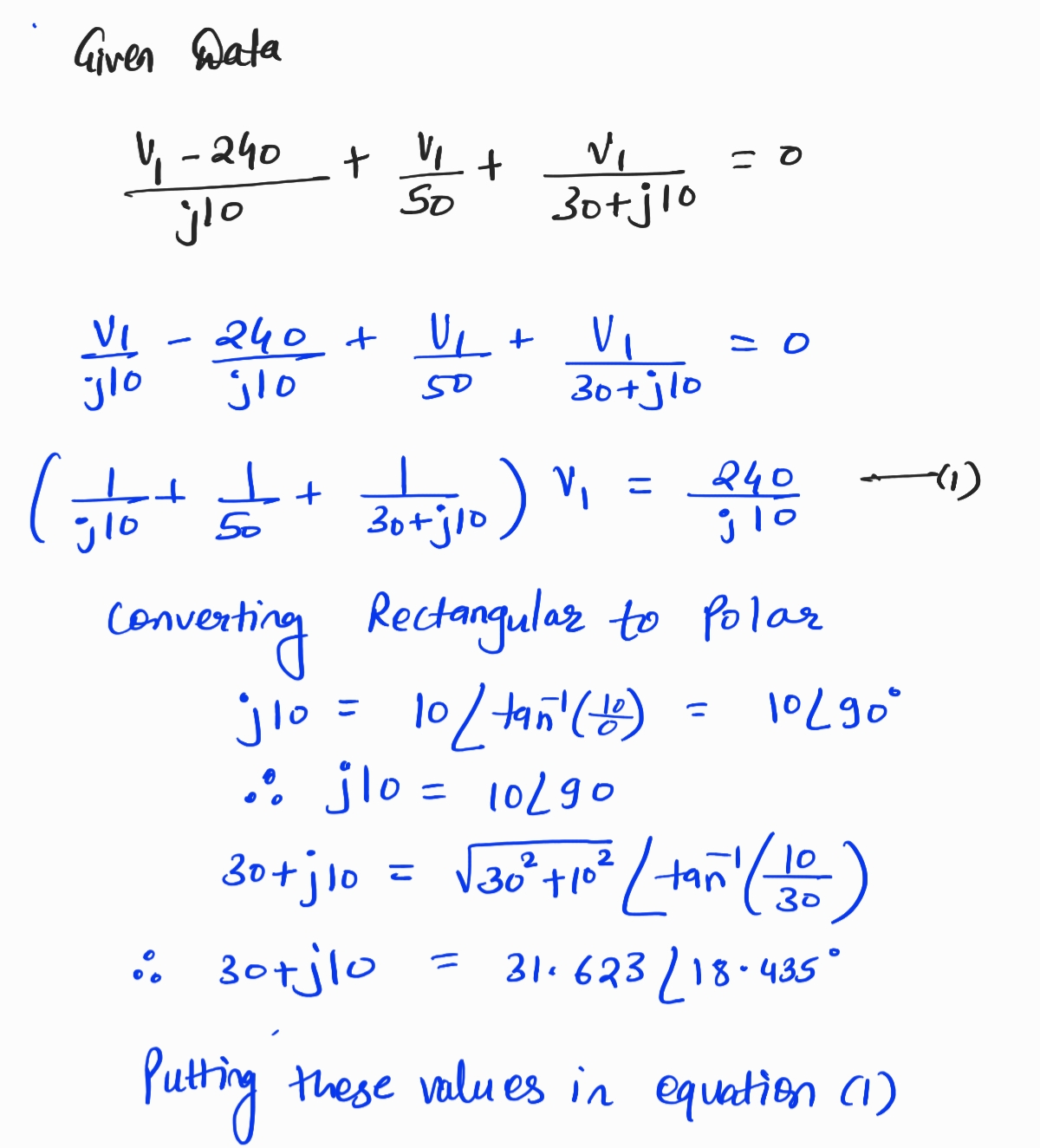Solve for v1
Introductory Circuit Analysis (13th Edition)
13th Edition
ISBN:9780133923605
Author:Robert L. Boylestad
Publisher:Robert L. Boylestad
Chapter1: Introduction
Section: Chapter Questions
Problem 1P: Visit your local library (at school or home) and describe the extent to which it provides literature...
Related questions
Question
Solve for v1
![The image contains an electrical circuit equation commonly found in circuit analysis problems. The equation is as follows:
\[
\frac{V_1 - 240}{j10} + \frac{V_1}{50} + \frac{V_1}{30 + j10} = 0
\]
### Explanation:
1. **Terms Involved:**
- \( V_1 \) is the variable representing voltage.
- \( j \) represents the imaginary unit in electrical engineering, equivalent to the square root of -1. It is used in the context of phasor analysis for alternating current (AC) circuits.
2. **Components:**
- The first term, \(\frac{V_1 - 240}{j10}\), represents the relationship of voltage across an impedance of \( j10 \).
- The second term, \(\frac{V_1}{50}\), is voltage divided by a resistance of \( 50 \) ohms.
- The third term, \(\frac{V_1}{30 + j10}\), indicates voltage across a complex impedance with both resistive (30 ohms) and reactive (j10 ohms) components.
3. **Equation Context:**
- The equation is likely set to 0 for balancing purposes, meaning the sum of voltage drops in the circuit equals zero, as per Kirchhoff's Voltage Law (KVL).
This type of equation is used to solve for unknown voltages in an AC circuit using complex impedance.](/v2/_next/image?url=https%3A%2F%2Fcontent.bartleby.com%2Fqna-images%2Fquestion%2Ff56ef61f-a71f-420a-b117-2f385a4a4df8%2F22b07973-ac76-4f07-b648-607f0f3e6a23%2Fuhot038_processed.jpeg&w=3840&q=75)
Transcribed Image Text:The image contains an electrical circuit equation commonly found in circuit analysis problems. The equation is as follows:
\[
\frac{V_1 - 240}{j10} + \frac{V_1}{50} + \frac{V_1}{30 + j10} = 0
\]
### Explanation:
1. **Terms Involved:**
- \( V_1 \) is the variable representing voltage.
- \( j \) represents the imaginary unit in electrical engineering, equivalent to the square root of -1. It is used in the context of phasor analysis for alternating current (AC) circuits.
2. **Components:**
- The first term, \(\frac{V_1 - 240}{j10}\), represents the relationship of voltage across an impedance of \( j10 \).
- The second term, \(\frac{V_1}{50}\), is voltage divided by a resistance of \( 50 \) ohms.
- The third term, \(\frac{V_1}{30 + j10}\), indicates voltage across a complex impedance with both resistive (30 ohms) and reactive (j10 ohms) components.
3. **Equation Context:**
- The equation is likely set to 0 for balancing purposes, meaning the sum of voltage drops in the circuit equals zero, as per Kirchhoff's Voltage Law (KVL).
This type of equation is used to solve for unknown voltages in an AC circuit using complex impedance.
Expert Solution
Step 1

Step by step
Solved in 4 steps with 4 images

Similar questions
Recommended textbooks for you

Introductory Circuit Analysis (13th Edition)
Electrical Engineering
ISBN:
9780133923605
Author:
Robert L. Boylestad
Publisher:
PEARSON

Delmar's Standard Textbook Of Electricity
Electrical Engineering
ISBN:
9781337900348
Author:
Stephen L. Herman
Publisher:
Cengage Learning

Programmable Logic Controllers
Electrical Engineering
ISBN:
9780073373843
Author:
Frank D. Petruzella
Publisher:
McGraw-Hill Education

Introductory Circuit Analysis (13th Edition)
Electrical Engineering
ISBN:
9780133923605
Author:
Robert L. Boylestad
Publisher:
PEARSON

Delmar's Standard Textbook Of Electricity
Electrical Engineering
ISBN:
9781337900348
Author:
Stephen L. Herman
Publisher:
Cengage Learning

Programmable Logic Controllers
Electrical Engineering
ISBN:
9780073373843
Author:
Frank D. Petruzella
Publisher:
McGraw-Hill Education

Fundamentals of Electric Circuits
Electrical Engineering
ISBN:
9780078028229
Author:
Charles K Alexander, Matthew Sadiku
Publisher:
McGraw-Hill Education

Electric Circuits. (11th Edition)
Electrical Engineering
ISBN:
9780134746968
Author:
James W. Nilsson, Susan Riedel
Publisher:
PEARSON

Engineering Electromagnetics
Electrical Engineering
ISBN:
9780078028151
Author:
Hayt, William H. (william Hart), Jr, BUCK, John A.
Publisher:
Mcgraw-hill Education,